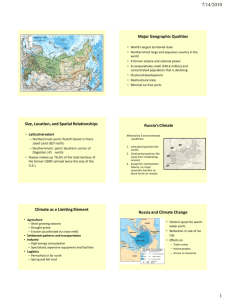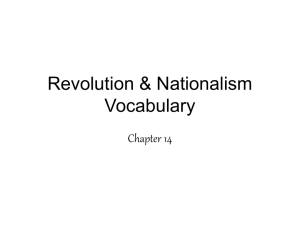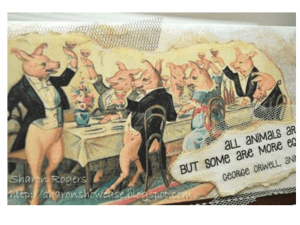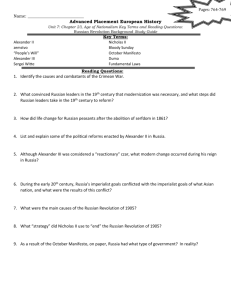08.03 Nationhood
advertisement
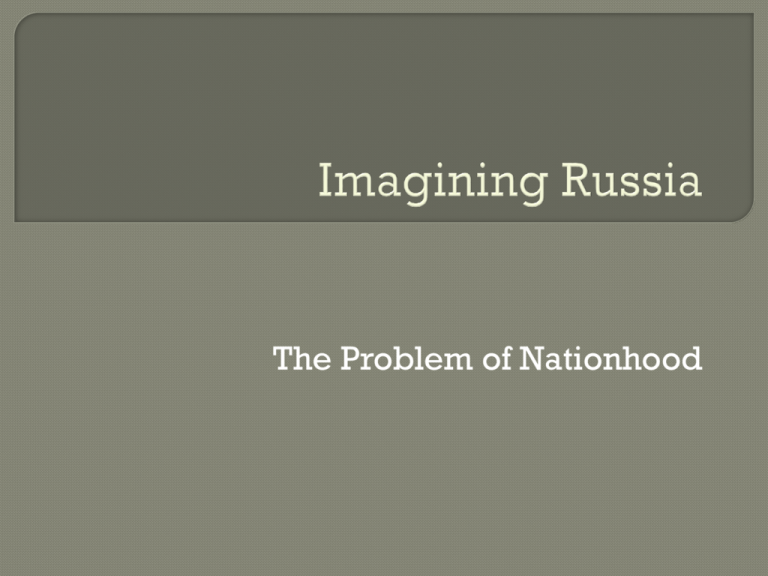
The Problem of Nationhood “… nationality… as well as nationalism, are cultural artefacts of a particular kind” (4) How is Russian national identity to be “created”? What are the individual problems that Russia faces in defining itself? Create a new Russian identity on the basis of the Russian Federation, formerly the RSFSR (Russian Soviet Federative Socialist Republic) Develop an economy. Invent a system of government. Define international relations with partners and neighbours. One nation? Or multinational?? “One language, one people, one religion” Adopted in Baltics, Ukraine, Moldova, Georgia Write out the Soviet period; rewrite history as a victim narrative. Problems Ethnic of minorities ignored differences lead to war in Moldova, Azerbaijan, Georgia Symbolic official language: Belarusian, Russian second Practice “on the ground”: Russian spoken Ukraine: effectively official language bilingual, but one The One dual identity of the Soviet citizen language of communication: Russian Widespread study of the cultures of the other peoples All should know their native language and culture and Russian language and culture. Continues the Soviet model of dual identity Integrate the common Soviet experience, Russian language as the unifying factors Limited recognition of multiconfessionality Limited regional ethnic dominance: Tatarstan, Chechnya, North Caucasus Limited status of regional languages State system of government Historical narrative Heroic figures from the past Religious identifiers Language Cultural figures Literature, music, art State symbols Holidays and popular customs Amalgamated elements of preRevolutionary Russia and Soviet Union Alexander Nevsky’s victory over German knights in 1242 Victory over Napoleon in 1812 World War I and White Army generals The victory in Europe in 1945 The first man in the Cosmos Many cities and streets given back their old pre-Soviet names (depending on local politics) Tsaritsyno – Stalingrad – Volgograd St Petersburg – Petrograd – Leningrad – St Petersburg (but still in the Leningrad oblast!) Tver – Kalinin – Tver BUT: Kaliningrad remained (formerly Königsberg, Germany) Pre-revolutionary Russian symbols return: the two-headed eagle, the new anthem taken from Glinka, the Russian tricolor flag. Eltsin Changes the Anthem To music by Mikhail Glinka Unofficial lyrics to ”Be Glorious, Russia!" by Viktor Radugin Be glorious, be glorious, motherland-Russia! You passed through the centuries and the thunderstorms And the sun shines above you And your destiny is bright. Above the ancient Moscow Kremlin Waves the banner with the two-headed eagle And the sacred words resound: Be glorious, Russia – my fatherland! In 2000 Vladimir Putin returns to the original (Soviet) anthem with new words. Compare the words of the anthems: which is more appropriate for the new state? Was the change a good move? Peter the Great: great transformer of Russia Yury Gagarin: first man in space Admiral Kolchak (leader of White resistance to Bolsheviks) Marshal Zhukov: Second World War general Actors Film and theatre directors Russian sportsmen Monument the Great to Peter Monument to 2nd World War General Zhukov Great World War leader Commanded the White forces against the Reds Executed by the Bolsheviks in Irkutsk in 1920 I … still stands in many city centres! Here, on Lenin Square in front of the Finland Station in St Petersburg His plays become very popular, many films based on his short stories Great revolutionary theatre director Murdered on Stalin’s orders in 1940 Bolsheviks persecuted religion in early days: priests shot or imprisoned, churches destroyed. Brief thaw during WWII. Until the 1980s religious practices discouraged through the workplace, Communist Youth League (komsomol). Russian Orthodox Church (ROC) profoundly infiltrated by the KGB: many preferred the Baptist and other underground movements. 1988: celebration Church of 1000 years of Christianity. services shown on TV for the first time. 1990: Aleksii II becomes patriarch of ROC. 1990 Law on Freedom of Religion; reinforced by the Russian Constitution of 1993. Russia invaded by American evangelists – Billy Graham, the Mormons, etc. During his term, presided over a revival of the ROC, close ties with the Russian state. Built ties with branches of the ROC abroad. Encouraged the reconstruction of many churches. Succeeded as Patriarch by Kirill of Smolensk. Popular Orthodox priest of church outside Moscow. Sermons, books, teaching, attracted and baptized many Probably too popular, also of Jewish origin. 9 September 1990 – murdered with an axe in the forest walking to his parish. … favors the role of the Russian Orthodox Church as an “inseparable part of the all-Russian historical, spiritual, and cultural heritage” and mentions the state’s recognition of Islam, Buddhism, Judaism, and other religions and local beliefs "traditionally existing in the Russian Federation.” It makes … distinctions between religious formations. First, between “religious organizations” which are granted all the rights of a legal entity, and “religious groups” which can carry out their activities within the limits of a whole range of restrictions. Second, between local and all-Russian religious organizations which differ in scope and mode of their operations. It also introduces a special category of “foreign religious organization” which cannot have its “representatives” in Russia unless invited by a Russian religious organization with permission of the Russian federal government. Up to 20 million, but about 5% practising. Concentrated in certain republics: Tatarstan, Bashkortostan, Caucasus republics, e.g. Chechnya. President Kadyrov of Chechnya constructs a huge Mosque in the capital Grozny. Difficult relationship with ROC. John Paul II unable to visit Russia. Recently visas for foreign Catholic priests refused. Catholics become object of extreme nationalists rallying around the ROC – along with Jews, Caucasians, homosexuals. (Right) The Catholic church in Tver, defaced swastikas and star of David. Is the emphasis on Russia and the ROC compatible with a multinational and confessional state? Given the religious revival in the FSU, will the Russian government be able to manage a state with compact, non-Slavic and non-Orthodox Christian minorities?




